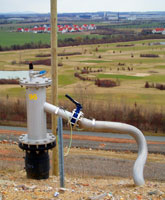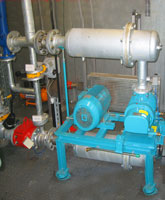 |
Landfill gas
On solid municipal waste landfills, landfill gas is built by anaerobic processes. It is rich in energy because of its main component methane (CH 4). Thus, a landfill is a huge biochemical reactor, where deposited substances are converted into utilisable gas, mainly composed of methane (CH 4) and carbon dioxide (CO 2). In addition to these main components, you also find significant quantities of oxygen (O 2) and nitrogen (N 2). As trace elements in landfill gas should be listed: compounds of silicon, sulphur, fluorine, chlorine, BTEX and hydrocarbons. Upcoming gas will be transported with the help of a landfill gas collection system to the gas utilisation plant where it is converted into energy. This is mostly done by gas engines.
We offer various services around landfill gas :
- Initial explorations: These surveys give information about the fact whether a gas collecting system could be installed and which kind of system should be used. Therefore, we measure the gaseous surface emissions by flame ionisation detectors (FID). Additionally, subsurface air samples will be taken from important places. These results will be added to the historic data such as quality and quantity of stored waste and give an estimation of the landfill gas formation. We show technical and economic aspects of utilisation and give proposals for realisation
.
- Gas cleaning processes: [
H2S problem in biogas ]:
Similar to biogas, landfill gas can contain trace gases, which have a negative effect on plant components of the utilisation system e.g. chlorine, fluorine, silicon. In this special case, our successful combined solution offers a remedy.
- Surveys of gaseous surface emissions by flame ionisation detectors discover weak points in surface sealing. This method is often used if upper sealing layer shows fissures or is penetrated (gas wells etc.)
- Efficiency controls of gas collection: In some countries, supervisory authorities require efficiency controls of gas collecting systems to be performed by external experts (third parties). The systems will be measured once which means that the following parameters will be determined at the manifolds of each pipeline: gas composition (main components methane, hydrocarbon, and oxygen), gas pressure, gas velocity and temperature, valve position, diameter of the measurement section, barometric air pressure. All measurements give an overview where in the system optimum has already been reached or where there is a demand of optimisation.
-
Camera inspection for visual check of the condition of single gas pipelines. Weak points such as sheared-off pipelines or water accumulation can be detected by this method.
- Weak point analysis: By using different methods such as FID inspections, efficiency controls, visual checks, camera inspections and pressure tests, weak points of the gas collecting systems can be discovered and possibilities of optimisation will be explained to optimise performance and removed faults
.
- We guarantee an environment-friendly use of landfill gas by performing checks of exhaust gases according to official requirements and current legislation.
- Suction tests can quantify the quantity of raw gas. Please ask for our detailed measurement program. By quantitative determination we will be able to point out possibilities of energy utilisation.
- Of course, we can carry out raw gas sampling and analysing, in collaboration with a respected laboratory. We interpret for you the results referring to gas production, amount of trace gases and their influence on installed components.
- We would be pleased to take over the entire or partial operation of your plant.
ˆtopˆ
Contact |
Imprint |



